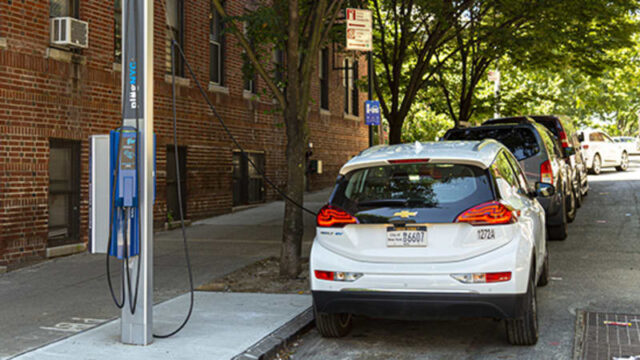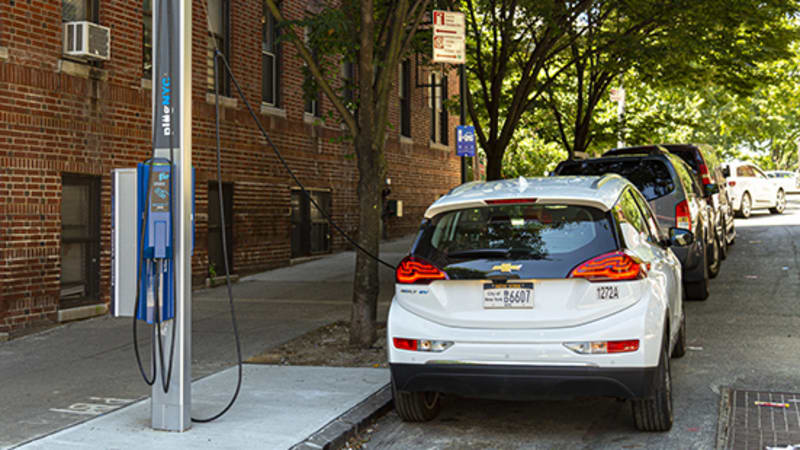
In the three years since New York City began installing curbside chargers for electric cars, demand for the spaces has boomed — both from EV owners looking for a place to plug in and from gas-engine drivers willing to risk a ticket in exchange for street parking.
“We expected moderate demand,” with usage rates around 15%, said Roy Rada, project manager for e-mobility innovation at Consolidated Edison Inc. It’s been “exponentially higher,” he said. The 100 chargers are online 99.9% of the time with an average utilization rate of 72% in 2024, according to the New York City Department of Transportation. That’s an impressive feat, especially since vehicles with internal-combustion engines blocked access to the chargers 20% of the time during the program’s first 18 months.
Building on that success, the citywide charging pilot that was originally expected to end in July will now likely extend an additional year, allowing the NYC DOT and Con Ed, the utility that provides electricity to homes and businesses in New York City, to continue to gather data on demand. They’re also beginning to plot out a larger-scale, post-pilot expansion, issuing last September a request for expressions of interest from EV-charging companies. The details of the extension are expected to be finalized in April, Con Ed said.
“Across usage, availability, awareness, everything has exceeded our original expectations when we first started this project,” Rada said in an interview. “Let’s take our learnings here, let’s start the next rollout, so we can make this more accessible to more people in our city.”
The city that’s home to more than 8 million people began installing public curbside EV charging stations in 2021 as a way to encourage the adoption of plug-in hybrid and electric cars, a key step in curbing air pollution and helping it reach carbon neutrality by 2050. EV demand, already choppy across developed markets as buyers grapple with high prices and interest rates, faces a particular hurdle in dense cities, where many car owners don’t have access to private parking spaces or personal garages like they might in the suburbs. Half of New Yorkers rely on street parking to store their cars — so-called “garage orphans” in EV-speak — making the roll-out of public charging important for Mayor Eric Adams’ push to decarbonize the city’s transportation sector.
“If you’re going to require a massive transition for people to move towards EVs, you have to provide them access to cheap options with EV charging,” said Amaiya Khardenavis, an analyst at Wood Mackenzie. “When you have a curbside charger, it just makes the economics of owning an EV much cheaper.”
A Canadian EV charging firm, FLO, was hired to install and maintain the curbside chargers for the pilot as well as 18 city fleet chargers located in front of municipal buildings, the last of which was completed in January. The street spots for the general public cost $2.50 per hour, or $1 per hour at night, covering both parking and charging. They’re located in all five boroughs, primarily Brooklyn. The level 2 chargers can provide an EV with a full charge in about four to eight hours, depending on the car’s battery size, and offer an alternative to expensive private-sector chargers that are concentrated in Manhattan.
FLO has a “very aggressive maintenance program involving both regular check-ins as well as alarms” that helps it keep the chargers in working order, said Travis Allan, its chief legal and public affairs officer. It also operates a dedicated parts depot in New York to allow it to quickly swap out components. “I think that this project is going to be a model for many other cities because it has achieved very high reliability of the stations,” he said.
The pilot has had lower rates of theft and vandalism than the partners had expected — despite more than one absentminded driver pulling away with their car still plugged in. The program has also come in under its $13.4 million budget, Rada said.
Still, it hasn’t been without its problems. Enforcing the “EV charging only” parking regulation has been difficult, Con Ed said in its fourth-quarter progress report. Last year, the NYPD said it issued a total of 2,197 summonses for parking violators using the spots.
That’s been the biggest frustration for New Yorker Thomas Vaughn, who likes to park his Volvo XC60 T8 plug-in hybrid at one of the curbside charging spots on East 67th St. when consulting for Manhattan’s Memorial Sloan Kettering Cancer Center.
“I could park here for $10 or I have to park inside the parking spot for a big $40 or $50,” he said on a windy Monday afternoon earlier this month, referring to a nearby garage. He snagged a spot that day but he’s usually not so lucky: At least 50 times during the last two years, he estimates, he’s found gas cars hogging the EV-only spots near the hospital instead. Sure enough, as Vaughn detached the charger from his mid-sized SUV, a combustion-engine Volkswagen Jetta SE was monopolizing an adjacent EV spot.
It’s gotten so bad that some plug-in owners call up their other EV-driving friends to come take over when they’re about to leave, he said. But availability still falls woefully short of demand. Although some homeowners charge in their own driveways or pay to use parking lots or garages with connections, drivers of the city’s 53,564 registered EVs simply want more.
“We wish there were more chargers, but there are very few in the city,” said driver Antoine Schetritt, who powers up at a curbside charging spot whenever it’s available. “You go to a European city, there are lots of chargers, so the infrastructure here is very behind.”
Still, Schetritt, managing partner at Cello Capital Management, recognizes the $2.50-an-hour rate is better than paying for a Manhattan parking garage and charger for his Tesla Model Y. Plus, it’s only a few blocks from home. “It’s a very slow charger,” he said. “The reason I use it is that I don’t really have alternatives that are close by.”
The NYC DOT has already received 32 responses from companies interested in being involved in the next stage of expansion, including from startups itselectric and Voltpost, the companies confirmed. Current partner FLO plans to submit a plan as well. NYC DOT has said it is seeking innovative designs that are cheaper, smaller and easier to install for the next stage. The expanded program aims to focus on neighborhoods with a “high number of taxi and for-hire vehicle drivers, few off-street parking options and a range of income levels,” NYC DOT Commissioner Ydanis Rodriguez said in an emailed comment.
No matter what happens next, scaling up will be key. According to a study by Con Edison and the city, New York City will need to support 1.5 million EVs by 2050 in order to achieve net-zero green-house gas emissions.
“It’s relatively easy to do a hundred now,” Rada said. But to reach those kinds of levels, “a lot of things have to change.”



































